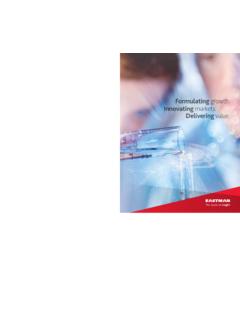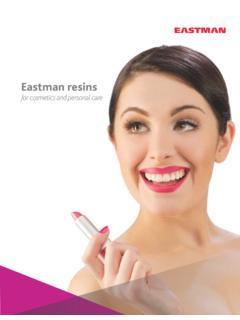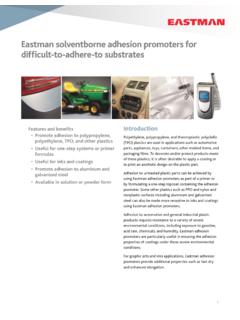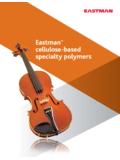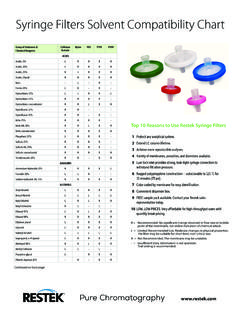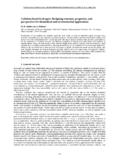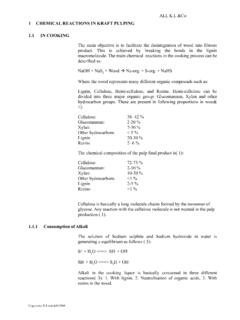Transcription of CB-37 Eastman SAIB for cosmetics and personal care
1 Eastman SAIB. and Eastman Sustane SAIB. (sucrose acetate isobutyrate). for cosmetics and personal care Contents Eastman SAIB and Eastman Sustane SAIB (sucrose acetate isobutyrate).. 3. 3. Physical 5. 7. 8. End-use 9. Lipstick and other makeup 9. Nail 9. 9. Other 9. Regulatory United European CAS Packaging and Eastman SAIB and Eastman Sustane SAIB. (sucrose acetate isobutyrate). CH2OR. OR. ROH2C O O O. RO OR. OR OR. CH2OR. Where O O CH3. R CCH3 , CCH , H. CH3. SAIB offers the following benefits in Introduction cosmetics applications: Sucrose acetate isobutyrate (SAIB) is a low odor, thermally Derived from sucrose, a natural sugar stable liquid, produced by the controlled esterification of Excellent solubility and compatibility with solvents, sugar (sucrose) with acetic and isobutyric anhydrides. In polymers, and modifiers its 100% form, SAIB is extremely viscous.
2 Therefore, low- Low volatility over a wide temperature range viscosity blends are available to provide ease of handling. Increased nonvolatile content while maintaining desired formulation viscosity SAIB is useful in various types of coatings such as Oil-phase density adjustment and emulsion lipsticks and nail lacquers. It can provide coatings of higher stabilization for oils in aqueous systems nonvolatile content, resulting in lower solvent requirements Nonyellowing; stable to UV light exposure and greater coverage (increased film deposition per Modification of film-former without appreciable application). Depending on the other formulation loss of film hardness ingredients, film adhesion and gloss may be improved. Improved adhesion to fingernails and skin SAIB is characterized as a modifying extender for film- Increased water resistance of films formers such as nitrocellulose and cellulose esters.
3 At levels Enhanced gloss up to 15% in some polymers, SAIB has minimal effect on Decreased evaporation rate of fragrance surface hardness. High levels of SAIB provide flexibility and ingredients, prolonging the scent reduce the glass transition temperature of the film-former. Eastman Sustane SAIB food-grade is used as a density- adjusting agent in beverages that contain essential flavoring oils. In this application, SAIB is mixed with the flavoring oil to increase the density of the oil phase before preparing the oil-in-water emulsion, thus increasing the stability of the beverage. Similarly, SAIB can improve the stability of fragrance oils in perfumes and toilet waters. The ability to emulsify SAIB makes it usable in various water-based applications. 3. Table 1 SAIB products Product Blend componenta INCI name Eastman Sustane SAIB food grade, kosher None Sucrose acetate isobutyrate Eastman Sustane SAIB MCT 20% caprylic/ Sucrose acetate isobutyrate (and).
4 Food grade, kosher capric triglyceride caprylic/capric triglyceride Eastman Sustane SAIB ET-10. 10% ethanol Sucrose acetate isobutyrate (and) alcohol food grade, kosher Eastman SAIB-100 None Sucrose acetate isobutyrate Eastman SAIB-90EA 10% ethyl acetate Sucrose acetate isobutyrate (and) ethyl acetate 10% Eastman Tecsol 3b Sucrose acetate isobutyrate (and) alcohol (and) methyl Eastman SAIB-90. solvents alcohol (and) MIBK (and) ethyl acetate (and) heptane a Composition given is typical of average lots. b Denatured ethyl alcohol, proprietary formula. Table 2 Applications for SAIB products Application Recommended SAIB products Benefits of SAIB. Lipstick, lip gloss, mascara, Eastman Sustane SAIB MCT. Extended wear, transfer resistance, water resistance foundation, concealer, etc. Eastman Sustane SAIB.
5 Eastman SAIB-90EA Chip and scratch resistance, leveling of brush strokes, Nail lacquers Eastman SAIB-90 increased film flexibility, gloss enhancement Skin creams and lotions Eastman Sustane SAIB MCT Increased water resistance Epilatories Eastman SAIB-100 Tack, low odor Eastman Sustane SAIB ET-10. Reduced evaporation rate of aroma chemicals, Colognes, toilet water, perfumes Eastman Sustane SAIB MCT. improved emulsion stability Eastman Sustane SAIB. 4. Physical properties fingernails, skin, and hair. If desired, tack can be reduced by other formulation ingredients. SAIB has a light color, low odor, low volatility, and good thermal stability. Its color stability to heat and ultraviolet An unusual property of SAIB is its abrupt decrease in vis- light is also good. Hydrolytic stability is excellent less cosity with increased temperature or with the addition of than hydrolyzed after 4 days in boiling water.
6 SAIB's solvents (Figures 1, 2, and 3). Typically, SAIB in its 100%. tack translates into good adhesion to substrates, including form is heated to about 70 C to facilitate transfer, , pouring or pumping. Figure 1 iscosity of Eastman SAIB. V Figure 3 Solution viscosity of Eastman SAIB. as influenced by temperature in ethyl acetate and in ethanol (Brookfield viscosity at 25 C). 100,000. 100,000. Brookfield viscosity, cP (mPa s). 10,000. 10,000. 1,000. Viscosity, cP (mPa s). 1,000. 100. 100. 10. 10. 1. 20 40 60 80 100 120 140 160. 1. Temperature, C 100 90 80 70 60 50 40 30. SAIB concn., wt%. Eastman SAIB in denatured ethyl alcohol Figure 2 iscosity of Eastman Sustane SAIB food V Eastman SAIB in ethyl acetate grade and food grade blends as influenced by temperature 8,000. 7,000. 6,000. Viscosity, cP (mPa s).
7 5,000. 4,000. 3,000. 2,000. 1,000. 0. 20 30 40 50 60 70 80. Temperature, C. Eastman Sustane SAIB food grade Eastman Sustane SAIB MCT. Eastman Sustane SAIB ET-10. 5. Table 3 Typical propertiesa Eastman SAIB-100b Molecular weight 832 856. Specific gravity @ 25 /25 C Weight per volume kg/L lb/Imperial gal gal Flash point, Cleveland Open Cup, C ( F) 260 (500). Solubility in water @ 25 C, wt% Appearance Viscous liquid, free from insoluble matter or haze Color (Pt-Co scale), max. 200. Color (Gardner scale) 1. Heat test color after 24 h @ 177 C, Gardner scale, max. 10. Onset of decomposition @ 760 mm, C ( F)c 215 (419). Haze, (Pt-Co standard) ppm 1. Refractive index, n 20 C/D Acid number, mg KOH/g, max. Saponification equivalent, g/eq 104 107. Coefficient of thermal expansion 3 10-4. (30 60 C), (cm3/cm3/ C).
8 Surface tension @ 19 C, dynes/cm2 28. Hydrolytic stability, refluxed in water for 96 h @ 100 C, wt% hydrolyzed Brookfield viscosityd @ 30 C, cP (mPa s) 100,000. Vapor pressure, 20 C, mmHg , Low-viscosity blends Eastman SAIB-90EA Eastman SAIB-90b Eastman Sustane SAIB MCT. SAIB, wt% 90 90 80. Solvent Ethyl acetate Denatured ethyl alcohol Caprylic/capric triglyceride Acid number, mg KOH/g, max. Weight per volume kg/L lb/Imperial gal gal Viscosity @ 25 C, cP (mPa s) 935 770 5,000. Flash point, Tag Closed Cup, C 22 17 >200. Color (Pt-Co scale), max. 200 200 200. Color (Gardner scale) 1 1 1. a Properties reported here are typical of average lots. Eastman makes no representation that the material in any particular shipment will conform exactly to the listed properties. b Food-grade products are also available (Table 1).
9 C Determined by differential scanning calorimetry in oxygen d See Figure 1. 6. Solubility The low solution viscosities listed in Table 4 indicate the excellent solubility of Eastman SAIB in many common solvents and fragrance ingredients. The solubility of SAIB. in some widely used propellants suggests a possible use in pressurized aerosol products. Table 4 Solution viscosity of Eastman SAIB. (50 wt% concentration, Brookfield viscosity at 25 C). Viscosity Solventa cP (mPa s). Esters Amyl acetate 10. n-Butyl acetate 9. Ethyl acetate 8. Ethyl lactate 21. Isobutyl acetate 9. Isopropyl acetate 8. Alcohols n-Butyl alcohol 15. Ethyl alcohol 12. Isobutyl alcohol 20. Isopropyl alcohol 14. Methyl alcohol 8. n-Propyl alcohol 14. Glycol ethers and glycol ether esters Butoxyethanol ( Eastman EB solvent) 21. Ethoxydiglycol ( Eastman DE solvent) 22.
10 Methoxyisopropanol ( Eastman PM solvent). 11. Methoxyisopropyl acetate ( Eastman PM acetate). 8. Hydrocarbons Hexane 6. Isododecane Immiscible Toluene 9. Ketones Acetone 6. Methyl ethyl ketone 6. Methyl isoamyl ketone 10. Methyl isobutyl ketone 8. a Solvents shown in bold are available from Eastman Chemical Company. 7. Compatibility Table 5 ompatibilitya of Eastman SAIB with various C. cosmetic ingredients In addition to being soluble in most solvents, SAIB is compatible with a large number of resins, plasticizers, oils, and humectants (Table 5). SAIB and each resin, Solventb plasticizer, or oil were dissolved in a volatile solvent and SAIB:resin cast as a film. The solvent was allowed to evaporate at Resin (type or INCI name) 1:4 1:2 2:1. room temperature. Acrylic C C C. Cellulose acetate SI c SI I.


